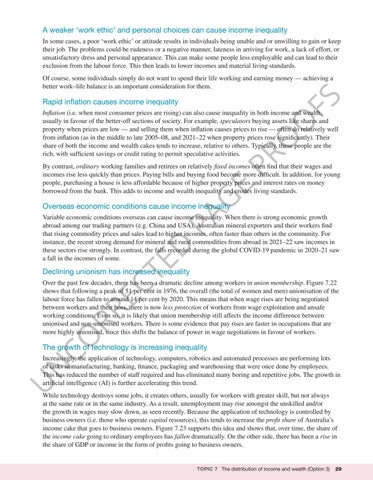“c07TheDistributionOfIncomeAndWealth_PrintPDF” — 2022/6/2 — 15:01 — page 29 — #29
A weaker ‘work ethic’ and personal choices can cause income inequality In some cases, a poor ‘work ethic’ or attitude results in individuals being unable and or unwilling to gain or keep their job. The problems could be rudeness or a negative manner, lateness in arriving for work, a lack of effort, or unsatisfactory dress and personal appearance. This can make some people less employable and can lead to their exclusion from the labour force. This then leads to lower incomes and material living standards.
FS
Of course, some individuals simply do not want to spend their life working and earning money — achieving a better work–life balance is an important consideration for them.
Rapid inflation causes income inequality
PR
O
O
Inflation (i.e. when most consumer prices are rising) can also cause inequality in both income and wealth, usually in favour of the better-off sections of society. For example, speculators buying assets like shares and property when prices are low — and selling them when inflation causes prices to rise — often do relatively well from inflation (as in the middle to late 2005–08, and 2021–22 when property prices rose significantly). Their share of both the income and wealth cakes tends to increase, relative to others. Typically, these people are the rich, with sufficient savings or credit rating to permit speculative activities.
G
E
By contrast, ordinary working families and retirees on relatively fixed incomes often find that their wages and incomes rise less quickly than prices. Paying bills and buying food become more difficult. In addition, for young people, purchasing a house is less affordable because of higher property prices and interest rates on money borrowed from the bank. This adds to income and wealth inequality and erodes living standards.
PA
Overseas economic conditions cause income inequality
TE
D
Variable economic conditions overseas can cause income inequality. When there is strong economic growth abroad among our trading partners (e.g. China and USA), Australian mineral exporters and their workers find that rising commodity prices and sales lead to higher incomes, often faster than others in the community. For instance, the recent strong demand for mineral and rural commodities from abroad in 2021–22 saw incomes in these sectors rise strongly. In contrast, the falls recorded during the global COVID-19 pandemic in 2020–21 saw a fall in the incomes of some.
Declining unionism has increased inequality
CO RR EC
Over the past few decades, there has been a dramatic decline among workers in union membership. Figure 7.22 shows that following a peak of 51 per cent in 1976, the overall (the total of women and men) unionisation of the labour force has fallen to around 14 per cent by 2020. This means that when wage rises are being negotiated between workers and their boss, there is now less protection of workers from wage exploitation and unsafe working conditions. Even so, it is likely that union membership still affects the income difference between unionised and non-unionised workers. There is some evidence that pay rises are faster in occupations that are more highly unionised, since this shifts the balance of power in wage negotiations in favour of workers.
The growth of technology is increasing inequality
U
N
Increasingly, the application of technology, computers, robotics and automated processes are performing lots of tasks in manufacturing, banking, finance, packaging and warehousing that were once done by employees. This has reduced the number of staff required and has eliminated many boring and repetitive jobs. The growth in artificial intelligence (AI) is further accelerating this trend.
While technology destroys some jobs, it creates others, usually for workers with greater skill, but not always at the same rate or in the same industry. As a result, unemployment may rise amongst the unskilled and/or the growth in wages may slow down, as seen recently. Because the application of technology is controlled by business owners (i.e. those who operate capital resources), this tends to increase the profit share of Australia’s income cake that goes to business owners. Figure 7.23 supports this idea and shows that, over time, the share of the income cake going to ordinary employees has fallen dramatically. On the other side, there has been a rise in the share of GDP or income in the form of profits going to business owners.
TOPIC 7 The distribution of income and wealth (Option 3)
29





















































